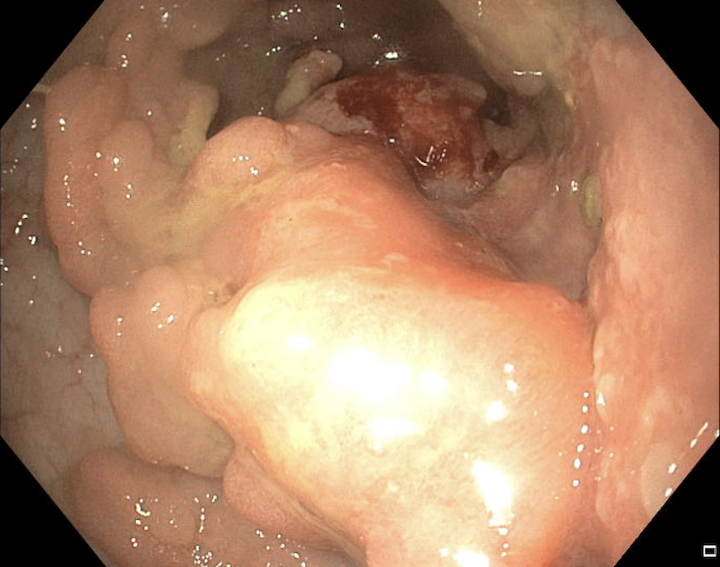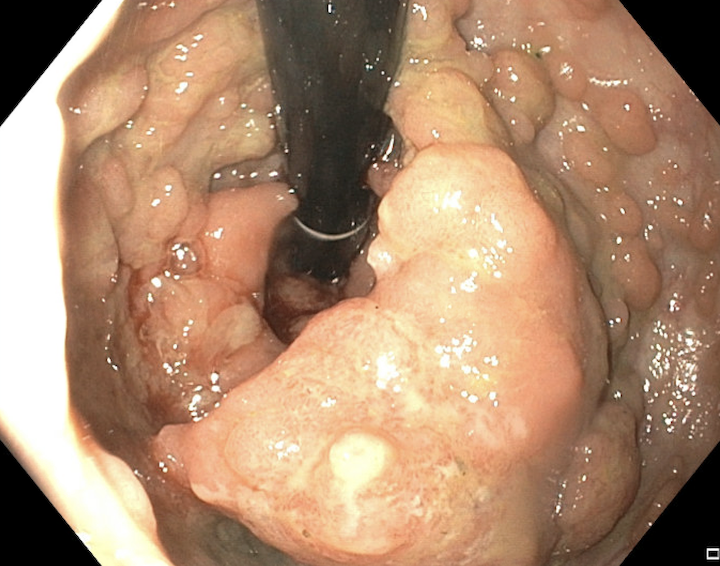Tuesday Poster Session
Category: Colon
P4625 - A Teenager With Metastatic Colorectal Cancer Secondary to FAP
Tuesday, October 28, 2025
10:30 AM - 4:00 PM PDT
Location: Exhibit Hall
- JB
John T. Brown, DO (he/him/his)
Western Michigan University Homer Stryker MD School of Medicine
Kalamazoo, MI
Presenting Author(s)
John T. Brown, DO, Gautam K. Pandrangi, DO, Susan Faragher. Bannon, MD
Western Michigan University Homer Stryker MD School of Medicine, Kalamazoo, MI
Introduction: Familial adenomatous polyposis (FAP) is caused by germline APC mutation, that can both be inherited or occur de novo. The average age for colorectal cancer onset in FAP is 39 years old. Here we discuss a case of a patient significantly under the age of the average onset of colorectal cancer in FAP.
Case Description/
Methods: A 19-year-old male with a past medical history of hemorrhoids, irritable bowel syndrome with mixed bowel habits (IBS-M), and vaping, p</span>resented to the emergency room due to persistent abdominal pain, diarrhea, weight loss, and occasional hematochezia. They had seen urgent care and primary care providers for the previously listed symptoms, but these symptoms were attributed to hemorrhoids and IBS-M. They were found to have a hemoglobin of 4.5 and a CT Chest/Abdomen/Pelvis showed a polypoid-like colonic neoplasm from the descending colon to the anorectal region with concern for hepatic and pulmonary metastatic disease. Flexible sigmoidoscopy revealed multiple malignant-appearing polypoid masses in the descending colon (Figure 1), sigmoid colon, rectosigmoid colon, and rectum (Figure 2). An EGD showed multiple sessile and adenomatous-appearing polyps in the cardia, fundus, body, and prepyloric region of the stomach as well as within the duodenum and proximal jejunum. Biopsies from the flexible sigmoidoscopy and subsequent liver biopsy revealed metastatic adenocarcinoma. Genetic testing revealed a variant in the APC gene and the diagnosis of FAP was made. The patient is currently undergoing neoadjuvant chemoradiation therapy.
Discussion: FAP typically leads to hundreds of adenomatous polyps within the colon/rectum between puberty and early twenties, with the average age of colorectal cancer being 39 years old. FAP commonly presents with lower GI bleeding, diarrhea, constipation, rectal polyps, fatigue, and abdominal pain. The patient had multiple outpatient and urgent care encounters for symptoms of diarrhea, vague abdominal pain, and occasional bloody stools. During these encounters, a rectal exam was never completed. If done, the findings of this examination could have suggested the presence of rectal polyps, and subsequently have sparked further work up of these symptoms. Early detection in patients with FAP, prophylactic surgery, and/or surveillance are essential to the efforts in prevention of colorectal cancer. If the patient had been diagnosed earlier, they could have undergone preventative measures or earlier intervention.

Figure: Figure 1) Flexible sigmoidoscopy showing malignant appearing multi-lobular polypoid masses in the sigmoid colon

Figure: Figure 2) Flexible sigmoidoscopy showing malignant appearing multi-lobular polypoid masses in the rectum
Disclosures:
John Brown indicated no relevant financial relationships.
Gautam Pandrangi indicated no relevant financial relationships.
Susan Bannon indicated no relevant financial relationships.
John T. Brown, DO, Gautam K. Pandrangi, DO, Susan Faragher. Bannon, MD. P4625 - A Teenager With Metastatic Colorectal Cancer Secondary to FAP, ACG 2025 Annual Scientific Meeting Abstracts. Phoenix, AZ: American College of Gastroenterology.
Western Michigan University Homer Stryker MD School of Medicine, Kalamazoo, MI
Introduction: Familial adenomatous polyposis (FAP) is caused by germline APC mutation, that can both be inherited or occur de novo. The average age for colorectal cancer onset in FAP is 39 years old. Here we discuss a case of a patient significantly under the age of the average onset of colorectal cancer in FAP.
Case Description/
Methods: A 19-year-old male with a past medical history of hemorrhoids, irritable bowel syndrome with mixed bowel habits (IBS-M), and vaping, p</span>resented to the emergency room due to persistent abdominal pain, diarrhea, weight loss, and occasional hematochezia. They had seen urgent care and primary care providers for the previously listed symptoms, but these symptoms were attributed to hemorrhoids and IBS-M. They were found to have a hemoglobin of 4.5 and a CT Chest/Abdomen/Pelvis showed a polypoid-like colonic neoplasm from the descending colon to the anorectal region with concern for hepatic and pulmonary metastatic disease. Flexible sigmoidoscopy revealed multiple malignant-appearing polypoid masses in the descending colon (Figure 1), sigmoid colon, rectosigmoid colon, and rectum (Figure 2). An EGD showed multiple sessile and adenomatous-appearing polyps in the cardia, fundus, body, and prepyloric region of the stomach as well as within the duodenum and proximal jejunum. Biopsies from the flexible sigmoidoscopy and subsequent liver biopsy revealed metastatic adenocarcinoma. Genetic testing revealed a variant in the APC gene and the diagnosis of FAP was made. The patient is currently undergoing neoadjuvant chemoradiation therapy.
Discussion: FAP typically leads to hundreds of adenomatous polyps within the colon/rectum between puberty and early twenties, with the average age of colorectal cancer being 39 years old. FAP commonly presents with lower GI bleeding, diarrhea, constipation, rectal polyps, fatigue, and abdominal pain. The patient had multiple outpatient and urgent care encounters for symptoms of diarrhea, vague abdominal pain, and occasional bloody stools. During these encounters, a rectal exam was never completed. If done, the findings of this examination could have suggested the presence of rectal polyps, and subsequently have sparked further work up of these symptoms. Early detection in patients with FAP, prophylactic surgery, and/or surveillance are essential to the efforts in prevention of colorectal cancer. If the patient had been diagnosed earlier, they could have undergone preventative measures or earlier intervention.

Figure: Figure 1) Flexible sigmoidoscopy showing malignant appearing multi-lobular polypoid masses in the sigmoid colon

Figure: Figure 2) Flexible sigmoidoscopy showing malignant appearing multi-lobular polypoid masses in the rectum
Disclosures:
John Brown indicated no relevant financial relationships.
Gautam Pandrangi indicated no relevant financial relationships.
Susan Bannon indicated no relevant financial relationships.
John T. Brown, DO, Gautam K. Pandrangi, DO, Susan Faragher. Bannon, MD. P4625 - A Teenager With Metastatic Colorectal Cancer Secondary to FAP, ACG 2025 Annual Scientific Meeting Abstracts. Phoenix, AZ: American College of Gastroenterology.
